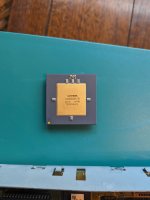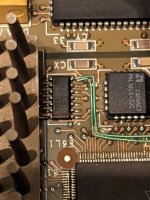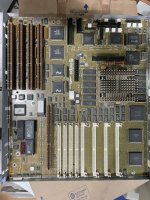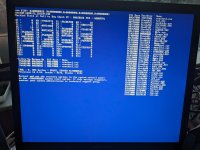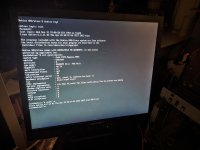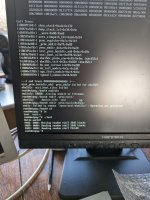TMM
Member
I recently came in possession of a MIPS ARCsystem Magnum 4000PC-50 but it is acting a little weirdly. It appears quite unstable in Windows NT4 and its behavior in the ARC runtime. For instance the ARC runtime on my Magnum will not reliably execute MIPS-II based ECOFF files that I produced whereas both Qemu and MAME will execute the programs just fine. I don't know if this is an emulator deficiency or if my board is weird. The reason I think my board may be weird is because of all of the bodge wires on it:
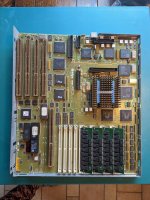
I have noticed that in place of a NEC μPD31432 ARC address path chip there's a chip called L1A7385 (The same part number listed on the Jazz development board at the Smithsonian https://www.si.edu/object/microsoft...d-jazz-rev-1-mips-r4000-processor:nmah_742557). There is also a whole extra chip mounted to it "Dead bug style" as well.
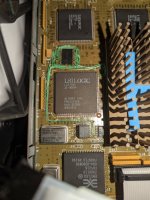
The problem I have is that I can't find any pictures of a Magnum 4000 motherboard online anywhere, so I do not know if this is normal or if my board is weird.
On Qemu and MAME Windows NT4 appears to be quite stable, whereas on my real machine it crashes under high I/O load. I've done quite a bit of troubleshooting (In no particular order):
* Visually inspected all the solder points on the chips.
* Used contact cleaner on the entire front surface of the board and all connectors.
* Tried with era appropriate scsi devices instead of modern ones.
* Tried Windows NT4.0 and 3.5.1.
* Wrote a memory testing program for the Arc firmware which, in a loop, writes patterns to every memory location not used by firmware and reads it back (no errors detected there). (https://github.com/hpvb/MIPS_ARC_memtest)
* Ported doom to the arc firmware (runs successful in attract mode for over an hour sometimes, then freezes).
* Tried booting with some cards removed, but the system will not function without them so that's not an option.
* Replaced the memory with known good memory.
* Replaced the Dallas clock chip with battery with new old stock.
* Removed the cpu, used contact cleaner in the socket, applied thermal paste instead of a pad.
* Applying light pressure to the board in various places, flexing it slightly, while the system is running to see if perhaps there's some hairline crackes.
Bootnote
For anyone interested I have also attached two ISO files to this post: ARCDoom_iso.zip which is doomgeneric ported to run "natively" on ARC as well as ARC_memtest_iso.zip. Which is, well, the memory test. The source code for the memory test is also here: https://github.com/hpvb/MIPS_ARC_memtest
Running the isos (on emulation make sure you select "initialize system" from the "Setup option at least once.)
Running ARCDoom: "Run a program" and then "cd:\doom"
Running Memtest: "Run a program" and then "cd:\memtest"

I have noticed that in place of a NEC μPD31432 ARC address path chip there's a chip called L1A7385 (The same part number listed on the Jazz development board at the Smithsonian https://www.si.edu/object/microsoft...d-jazz-rev-1-mips-r4000-processor:nmah_742557). There is also a whole extra chip mounted to it "Dead bug style" as well.

The problem I have is that I can't find any pictures of a Magnum 4000 motherboard online anywhere, so I do not know if this is normal or if my board is weird.
On Qemu and MAME Windows NT4 appears to be quite stable, whereas on my real machine it crashes under high I/O load. I've done quite a bit of troubleshooting (In no particular order):
* Visually inspected all the solder points on the chips.
* Used contact cleaner on the entire front surface of the board and all connectors.
* Tried with era appropriate scsi devices instead of modern ones.
* Tried Windows NT4.0 and 3.5.1.
* Wrote a memory testing program for the Arc firmware which, in a loop, writes patterns to every memory location not used by firmware and reads it back (no errors detected there). (https://github.com/hpvb/MIPS_ARC_memtest)
* Ported doom to the arc firmware (runs successful in attract mode for over an hour sometimes, then freezes).
* Tried booting with some cards removed, but the system will not function without them so that's not an option.
* Replaced the memory with known good memory.
* Replaced the Dallas clock chip with battery with new old stock.
* Removed the cpu, used contact cleaner in the socket, applied thermal paste instead of a pad.
* Applying light pressure to the board in various places, flexing it slightly, while the system is running to see if perhaps there's some hairline crackes.
Bootnote
For anyone interested I have also attached two ISO files to this post: ARCDoom_iso.zip which is doomgeneric ported to run "natively" on ARC as well as ARC_memtest_iso.zip. Which is, well, the memory test. The source code for the memory test is also here: https://github.com/hpvb/MIPS_ARC_memtest
Running the isos (on emulation make sure you select "initialize system" from the "Setup option at least once.)
Running ARCDoom: "Run a program" and then "cd:\doom"
Running Memtest: "Run a program" and then "cd:\memtest"

